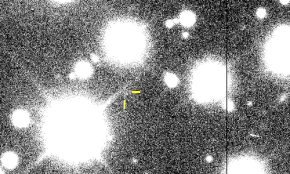Erinome, also known as Jupiter XXV, is a retrograde irregular satellite of Jupiter. It was discovered by a team of astronomers from the University of Hawaii led by Scott S. Sheppard in 2000, and given the temporary designation S/2000 J 4.[6][1]
 Erinome imaged by the Canada-France-Hawaii Telescope in December 2001 | |
| Discovery[1] | |
|---|---|
| Discovered by | Scott S. Sheppard David C. Jewitt Yanga R. Fernandez Eugene A. Magnier |
| Discovery site | Mauna Kea Observatory |
| Discovery date | 23 November 2000 |
| Designations | |
Designation | Jupiter XXV |
Named after | Erinoma (Greek form unknown)[lower-alpha 1] |
| S/2000 J 4 | |
| Orbital characteristics[2] | |
| Epoch 17 December 2020 (JD 2459200.5) | |
| Observation arc | 16.34 yr (5,967 days) |
| 0.1494286 AU (22,354,200 km) | |
| Eccentricity | 0.2052559 |
| –682.80 d | |
| 98.99686° | |
| 0° 31m 38.062s / day | |
| Inclination | 164.81976° (to ecliptic) |
| 34.02660° | |
| 81.11760° | |
| Satellite of | Jupiter |
| Group | Carme group |
| Physical characteristics[3] | |
| 3 km | |
| Albedo | 0.04 (assumed) |
Spectral type | B–V = 0.72 ± 0.06, V–R = 0.42 ± 0.04[4] |
| 22.8[5] | |
| 16.0[2] | |
Erinome is about 3 kilometres in diameter, and orbits Jupiter at an average distance of 22,986,000 km in 682.80 days, at an inclination of 164° to the ecliptic (162° to Jupiter's equator), in a retrograde direction and with an eccentricity of 0.2552.
It belongs to the Carme group, made up of irregular retrograde moons orbiting Jupiter at a distance ranging between 23 and 24 Gm and at an inclination of about 165°.
Name
Erinome was named in October 2002 after the mythological Erinoma, a Cypriot woman said by the discovery group to be a "daughter of Celes, compelled by Venus to fall in love with Jupiter."[7] In the surviving myths however, it is actually Jupiter (Zeus) whom Venus (Aphrodite) makes fall in love with Erinoma, in order to ruin her.[lower-alpha 1]
The final -a vowel of the name was changed to -e to accord with IAU naming conventions for retrograde moons.[7] The story is only known in Latin, and manuscripts have the name as Erinoma, Erinona and Erittoma. The original Greek name, and thus the stressed syllable in Latin, is unknown. It might be a late corruption of Eurynome,[lower-alpha 1] in which case the stress would be on the third syllable (/ɛrɪˈnəmiː/?). Since there is no moon named 'Eurynome' as of 2020[update], this would not be ambiguous.
Notes
References
Wikiwand in your browser!
Seamless Wikipedia browsing. On steroids.
Every time you click a link to Wikipedia, Wiktionary or Wikiquote in your browser's search results, it will show the modern Wikiwand interface.
Wikiwand extension is a five stars, simple, with minimum permission required to keep your browsing private, safe and transparent.
